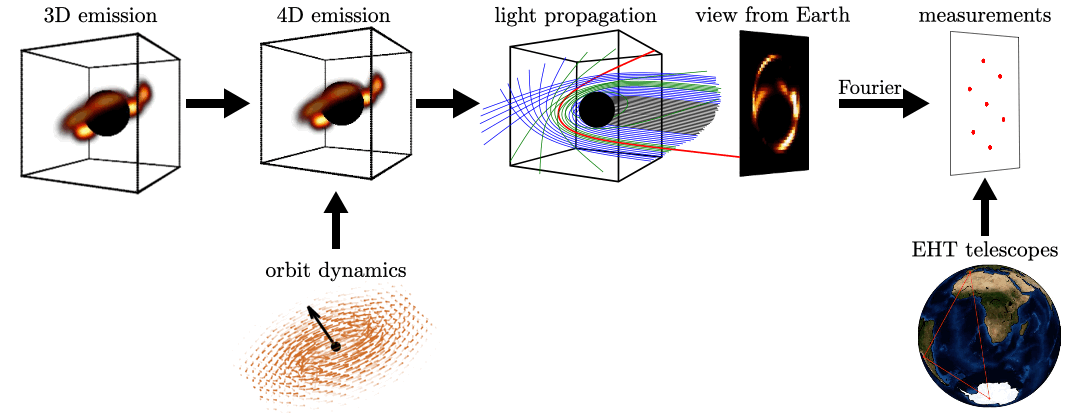1California Institute of Technology 2Google Research 3Princeton 4UC Berkeley

1California Institute of Technology 2Google Research 3Princeton 4UC Berkeley

We formulate an approach for a novel tomographic reconstruction problem: recovering the emission distribution in orbit around a black hole using observations captured from a single viewpoint over time. This is achieved by leveraging expected physics around a black hole: gravitational lensing and emission flow modeled by Keplerian orbital dynamics. The observations are simulated Event Horizon Telescope (EHT) measurements that place a sparse set of constraints on the Fourier components of the 2D images over time.
Measurements from the Event Horizon Telescope enabled the visualization of light emission around a black hole for the first time. So far, these measurements have been used to recover a 2D image under the assumption that the emission field is static over the period of acquisition. In this work, we propose BHNeRF, a novel tomography approach that leverages gravitational lensing to recover the continuous 3D emission field near a black hole. Compared to other 3D reconstruction or tomography settings, this task poses two significant challenges: first, rays near black holes follow curved paths dictated by general relativity, and second, we only observe measurements from a single viewpoint. Our method captures the unknown emission field using a continuous volumetric function parameterized by a coordinate-based neural network, and uses knowledge of Keplerian orbital dynamics to establish correspondence between 3D points over time. Together, these enable BHNeRF to recover accurate 3D emission fields, even in challenging situations with sparse measurements and uncertain orbital dynamics. This work takes the first steps in showing how measurements from the Event Horizon Telescope could be used to recover evolving 3D emission around the supermassive black hole in our Galactic center.
paper [pdf] code [Github] supplement [pdf]
@inproceedings{levis2022gravitationally,
title={Gravitationally Lensed Black Hole Emission Tomography},
author={Levis, Aviad and Srinivasan, Pratul P and Chael, Andrew A and Ng, Ren and Bouman, Katherine L},
booktitle={Proceedings of the IEEE/CVF Conference on Computer Vision and Pattern Recognition},
pages={19841--19850},
year={2022}
}